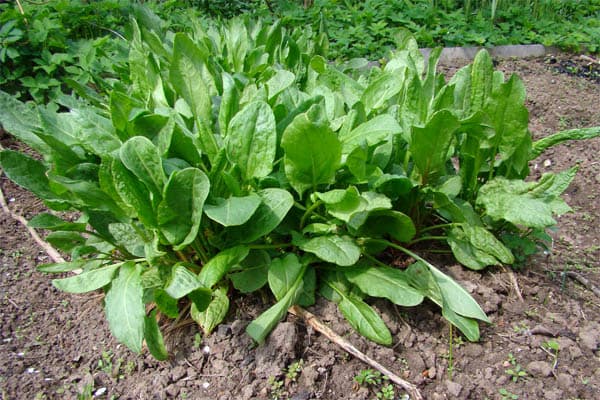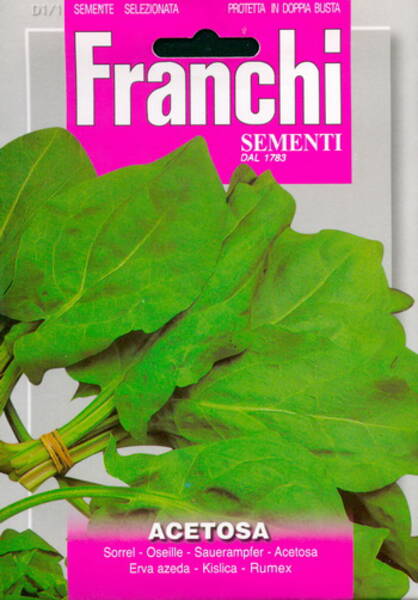Perennial, cold-resistant plant. Mid-season variety (the period from full sprouting to the first cut is 40-45 days). The rosette of leaves is erect, 30 cm in diameter, 35-40 cm high.
The leaf is elongated-oval, green, large, juicy and smooth. The petiole is of medium length. The taste is slightly acidic.
Sorrel contains a large amount of vitamin C, carotene, B vitamins, valuable organic acids. It is used fresh and for canning.
Productivity up to 6.0-7.0 kg / m2. Sowing is done in April-May. To obtain early production, summer and winter crops are possible.
1,0 g = 300-400 seeds.
Agricultural technology.
Sorrel is grown by direct sowing of seeds into the ground. The depth of seed placement is not more than 0.5 cm. Seedlings appear in 12-15 days. Further care consists in loosening the soil, regular watering and fertilizing with complex mineral fertilizers. Green leaf mass is harvested at intervals of 15-20 days.
Proper care of sorrel after planting consists of loosening row spacing, weeding, fertilizing and watering. It is desirable to mulch the soil, which will reduce the dose of watering and loosening. Leaf litter is well suited for these purposes. It is also recommended early spring top dressing with nitrogen and complex fertilizers 3-4 times per season: 1 time in early spring with nitrogen fertilizers, and then during the summer - complex. At the end of August, it is advisable to fertilize with phosphorus-potassium fertilizers so that the plants successfully overwinter. Watering should be carried out regularly. It is especially important to water the plants abundantly in dry and hot weather, otherwise all previous efforts can be nullified.

* Sorrel leaves contain a large amount of oxalic acid, as well as citric, malic, salicylic and succinic acids.
Sorrel is also rich in vitamin C, provitamin A, B vitamins, rutin, valuable proteins, glycosides, iron and potassium.
Shchi, borsch, okroshka, salads, pie fillings are prepared from juicy sour sorrel leaves. The plant is also used in folk medicine.
In the Urals, sorrel has long been used to treat scurvy. It is recommended to improve digestion, with allergic and skin diseases, with tonsillitis, and also as an appetite enhancer.
In oriental medicine, sorrel is used to treat wounds. The best sorrel is spring, it has a blood-purifying effect.
Therefore, at a time when sorrel leaves are just emerging, it is better to use it raw, adding it to salads.
It is advisable to cook cabbage soup and other dishes later, when the leaves become darker and rougher.
Eng.: Sorrel. Suom.: Niittysuolaheinä. Sven.: Ängssyra.
* Sorrel is rich in vitamin C, calcium, potassium, magnesium and oxalic acid.
Sorrel is the richest source of vitamins C and A. Only 10 leaves of sorrel are enough to fill the body's daily need for these vitamins.
Sorrel contains folic acid, which stabilizes DNA and fights cancer. Sorrel is a source of calcium, potassium and magnesium.
The disadvantage of sorrel is that it contains oxalic acid, which, when combined with calcium, can form kidney stones. Therefore, sorrel is absolutely contraindicated for people suffering from urolithiasis.
By the way, sorrel is the champion in the content of oxalic acid: it contains more of it than in spinach and 25 times more than in parsley. But, the younger the sorrel, the less oxalic acid it contains.
If you grow sorrel in your area, then try to collect it before July 1 - the longer the sorrel grows, the more oxalic acid accumulates in it.
How to store:
1. Wash fresh sorrel, dry it with a paper towel, put it in a glass of water and store for 1-2 days.
2. Wash the sorrel, dry it with a paper towel, put it in a vacuum container or in a special cling film and store it in the freezer for about a year.
3. Dry, chop sorrel leaves - and then add as a seasoning to all kinds of dishes.
How to cook:
Treat sorrel like a seasoning and don't overdo it. Add sorrel to salads. If you like sorrel soup, then cook it correctly to get the maximum dose of vitamin C:
- before cooking, boil the soup water for 5 minutes - this is necessary so that oxygen, which is the main destroyer of vitamin C, comes out of the water;
- then throw a pinch of salt into the water - it will displace the remaining oxygen;
- add sorrel to the soup 5 minutes before the end of cooking - and then the destruction of vitamin C will be minimal.
With all this, the decrease in the amount of oxalic acid during cooking will be insignificant, by about 5-15%.











